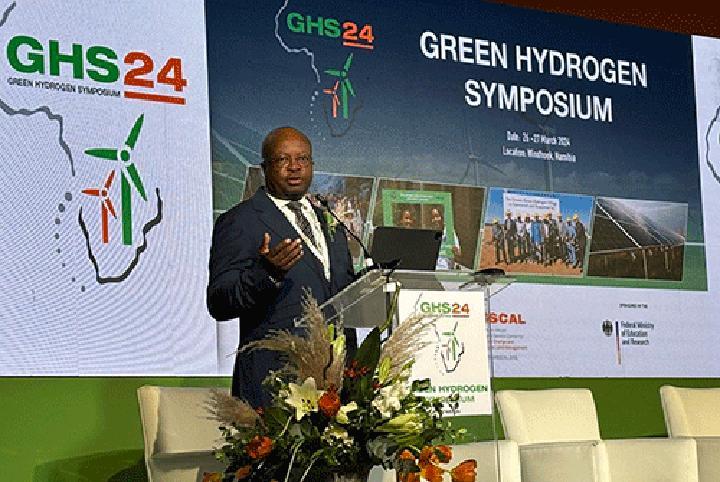Africa-Press – Namibia. Namibia’s infant green hydrogen industry can greatly assist African and specifically Southern African Development Community (SADC) countries to confront a number of interlinked challenges, including climate change, low economic growth rates and poverty.
This was the sentiment expressed by agriculture, water and land reform deputy minister, Anna Shiweda.
The deputy minister made these remarks at the two-day green hydrogen symposium, which took place under the theme of “green hydrogen in practice: pilot projects and youth for GH2 scholarships”.
The symposium concluded in the capital yesterday. During the event, Shiweda also noted that the only way to limit global warming to not more than 1.5°C is by considering green hydrogen as a clean energy solution.
“For this reason, taking advantage of our abundant natural resources, such as, wind and solar which have the capacity for green hydrogen production, African countries could become more energy independent through the promotion and support of the development of zero-carbon industrialisation, which will in turn, create both economic growth, employment and significant opportunities for energy exports,” said Shiweda.
The deputy minister continued that international and regional collaboration will be the key in the development of a shared hydrogen economy and action plans that will set a standard for the success and realisation of Green Hydrogen production potential.
“We cannot achieve our hydrogen ambitions in isolation. Therefore, we should find an amicable way to create a symbiotic relationship with the policymakers, industry players and all relevant stakeholders going forward to realise the success of green hydrogen potential,” Shiweda stated.
Meanwhile, at the same event, the chairperson of Namibia’s Green Hydrogen Council, Obeth Kandjoze, stated that thus far hundreds of scholarships have been awarded, hundreds of green jobs created, and a national strategy has been developed and is under execution. He also stated that “in just a few months from today, Namibia will produce its first green hydrogen and green ammonia”.
Kandjoze added that in August 2021, following extensive discussions and negotiations with German counterparts, Namibia concluded a Joint Communiqué of Intent (JCoI) which availed a grant funding amounting to 40 million euros.
In addition, after the Southern African Science Service Centre for Climate Change and Adaptive Land Management (SASSCAL) issued a public call for participation in 2022, more than 25 project concepts were submitted for funding hydrogen-related initiatives. In August 2022 and after extensive evaluations from both the Namibian and German governments, four projects were announced, three of which have gone on to sign commencement contracts.
Kandjoze pointed out that Namibia’s green hydrogen village is projected to generate an annual output of up to 100 tonnes of green ammonia and more than 400 tonnes of green tomatoes during its pilot phase. The project is now 80% complete and is expected to start producing green hydrogen and ammonia as early as July 2024.
“As of November 2023, the project has reportedly employed more than two hundred Namibians from more than 30 small and medium-sized enterprises (SMEs), the majority of which are located in the surrounding communities,” said Kandjoze.
The Green Hydrogen Council chairperson added that after extensive negotiations, a contract has been finalized for the HyRail project. This project is spearheaded by TransNamib, Hyphen Technical and CMB Tech and includes UNAM as an academic partner.
“This project will demonstrate the ‘use case’ of hydrogen in the rail transportation sector, in the form of dual fuel converted train. The locomotive conversion is anticipated to commence in the latter part of the year, and initial timelines suggest that it will be commissioned before the end of 2025,” said Kandjoze during day one of the symposium.
According to Kandjoze, the HyRail project, as well as two other pilot projects, are symbolic of what the future looks like, namely a case of well-established local conglomerates coexisting with previously disadvantaged Namibian youth, to jointly lead the green revolution, through research and tangible development.
The Green Hydrogen Symposium, which concluded yesterday, aimed to provide a comprehensive mid-term status report on ongoing pilot projects and the youth for green hydrogen scholarships. The symposium served as a platform for key stakeholders to witness the advancements and achievements in Namibia’s green hydrogen sector, showcasing the progress and results of the projects under the JCoI.
The symposium featured presentations and moderated open discussions over the two days. Recipients of grants present the status quo of pilot projects, sharing insights into progress, major highlights, challenges, and ongoing capacity building initiatives. Research institutions, industry players from Namibia and Germany, and programme coordinator SASSCAL used the symposium as a unique opportunity to explore future collaborative opportunities.
For More News And Analysis About Namibia Follow Africa-Press






